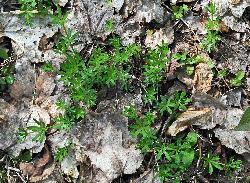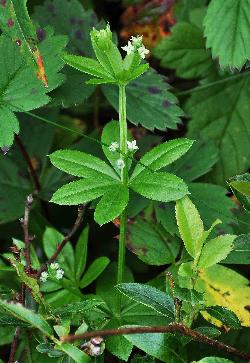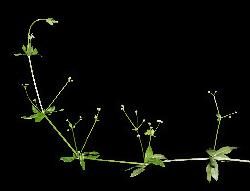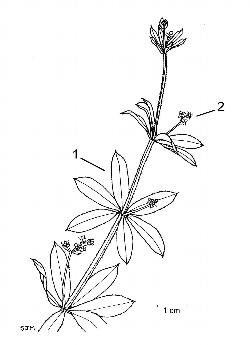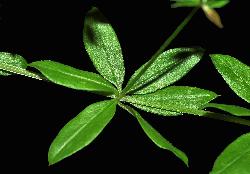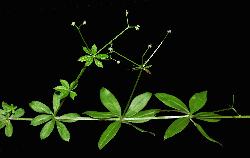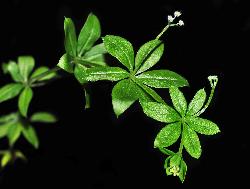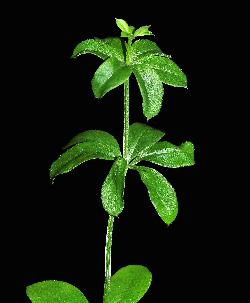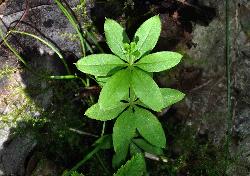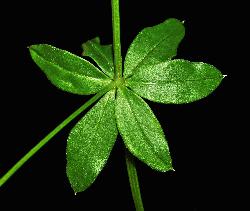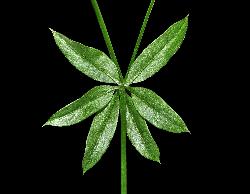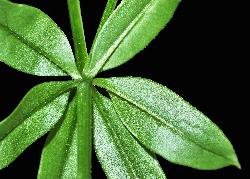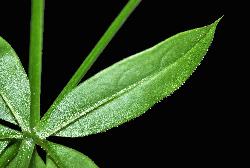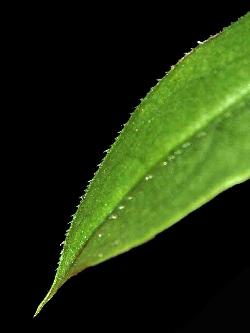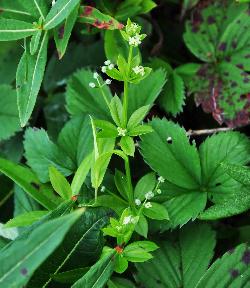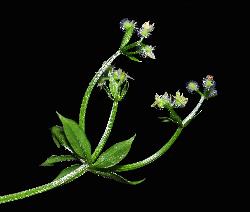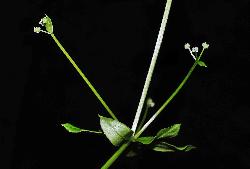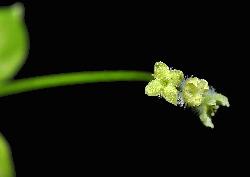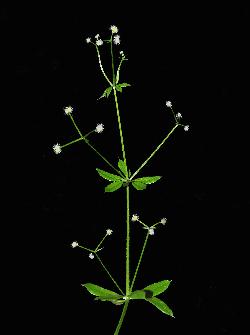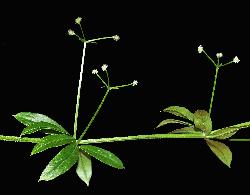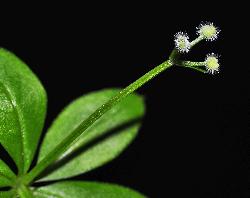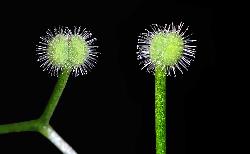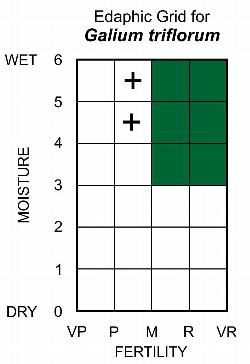Fr: gaillet à trois fleurs, gaillet odorant
Rubiaceae - Bedstraw Family
Note: Numbers given in square brackets in the text refer to the images presented above; image numbers are displayed to the lower left of each image.
General: A weak-stemmed decumbent perennial forb [1], arising from a creeping rhizome. Small greenish-white flowers are followed by a pair of small spherical bristly dry fruits [2–3]. Reproduction is by seed or vegetative propagation of the rhizome. The common name, sweet-scented bedstraw, was used for this species in Newfoundland’s Forest Site Classification Manual (Meades and Moore 1989), but this common name is also applied to an introduced species of bedstraw, Galium odoratum (L.) Scop., commonly grown in gardens; therefore, the common names fragrant bedstraw (most commonly used) or threeflower bedstraw are recommended to avoid confusion with the garden species.
Key Features: (numbers 1–3 refer to the illustration [4])
1. Leaves in whorls of 6, with elliptic or oblanceolate sessile blades; veins on the lower surface armed with short forward-facing bristles.
2. Flowers small, greenish-white, usually occurring in stalked terminal or axillary branches of 3, each flower has a 4-lobed corolla.
3. The dry indehiscent fruit (a schizocarp) is composed of a pair of small spherical mericarps that are covered with small hooked bristles.
Stems: Herbaceous, weak, 4-angled, vertically ridged, and 2–8 dm long. Stems typically trail across the ground or climb loosely on surrounding vegetation [5–6]. The stems are smooth to slightly scabrous along the raised ridges, with small downward-pointing (retrorse) barbs [7–8]. Branches develop from the nodes, but are usually shorter than the main stem and have fewer leaves per whorl.
Leaves: Whorls of usually 6 leaves occur at each node of the main stem [9–11]; lateral branches may have leaves in whorls of 4 or 5. Leaves in upper whorls of the stem are usually smaller than leaves of lower whorls; leaves at the base of the stem wither early. Leaf blades are simple, sessile, elliptic, oblong, or oblanceolate, 2–8.5 cm long, with a single vein; the blades taper to a cuneate base; apices are acute to rounded and end in a short cuspidate tip [12–14]. Leaf margins are ciliate, with short forward-facing (antrorse) barbs, while the vein on the lower blade surface is armed with backward-facing (retrorse) barbs [14–17]. Galium plants were used as stuffing in early bedding, hence the common name, bedstraw, for the genus, while the vanilla scent of the dried foliage of Galium triflorum is responsible for the common name, fragrant bedstraw.
Flowers: Bisexual; arranged in stalked terminal and axillary clusters of 3 flowers [18–20]. Peduncles are usually longer than the leaves and terminate in 3 shorter pedicels; 1 or 2 small linear to lanceolate bracts subtend the pedicels of each flowering branch. Individual flowers are small, 2–3 mm across, greenish-white, with a flat (rotate) corolla of 4 triangular to ovate lobes with abruptly acuminate tips [21]; sepals are lacking. Flowers have 4 short stamens that alternate with the petals and a 2-celled inferior ovary, consisting of 2 spherical carpels, attached laterally at the top of the pedicel and covered with minute hooked bristles. The 2-branched style of the pistil, visible above the corolla, is surrounded by a nectariferous disc. Flowers bloom in July to August and are pollinated by a variety of fly and bee species (entomophily) that visit the flowers to feed on nectar.
Fruit: A dry indehiscent schizocarp, 2–2.5 mm long, composed of 2 spherical mericarps (mature carpels), borne on short pedicels in clusters of 3, terminating a long peduncle [22–24]. The mericarps are covered with numerous hooked bristles and each contain one seed [25–26]. The mericarps usually separate from each other at or before dispersal, which occurs when the bristles of the fruit become tangled in the fur of passing animals (ectozoochory).
Ecology and Habitat: Fragrant bedstraw occurs in closed and open forests with moist to wet nutrient-rich soils. It usually has less than 5% cover, but on cutovers it can spread by rhizomes to form large patches in early succession. It also occurs in turfy limestone barrens, growing within the low shrub cover and in moist ravines.
Edaphic Grid: See image [27]: the Edaphic Grid for Galium triflorum.
Forest Types: Fragrant bedstraw has not been recorded from Labrador forest types, but is found in the following Newfoundland forest types:
Abietum rubetosum (Rubus-Balsam Fir Forest Subassociation)
Aceretum galietosum (Galium-Mountain Maple Thicket Subassociation)
Alnetum caricetosum (Carex-Alder Swamp Subassociation)
Alnetum dryopteretosum (Dryopteris-Alder Swamp Subassociation)
Alnetum lycopodietosum (Lycopodium-Alder Swamp Subassociation)
Alnetum solidagetosum (Solidago-Alder Swamp Subassociation)
Alnetum typicum (Moist Alder Swamp Subassociation)
Betuletum rubetosum (Rubus-Birch Forest Subassociation)
Betuletum typicum (White Birch-Mountain Alder Forest Subassociation)
Carici-Piceetum (Carex-Black Spruce Fen Association)
Osmundo-Piceetum (Osmunda-Black Spruce Fen Subassociation)
Succession: Fragrant bedstraw can survive fire and harvesting disturbance through buried seeds and asexual reproduction from rhizomes. Cutovers in central Newfoundland had up to 5–15% cover in the first 10 years after cutting on moist sites (Northlands 1990). Recovery after low intensity fire is possible through surviving rhizomes and buried seeds, but after high intensity fires recovery is slow, requiring input of seed from distant surviving stands (Gucker 2005).
Distribution: Fragrant bedstraw is a circumboreal species with a Canadian range that extends from Newfoundland and Labrador west to British Columbia, and north to the Yukon and Northwest Territories, to about 69° 30’ N (Scoggan 1978), but is absent from Nunavut (Brouillet et al. 2010+). Within the Province, the range of fragrant bedstraw extends across Newfoundland, but is absent or rare in the southern Avalon and south coast; it extends north in Labrador to the Churchill River Valley (Scoggan 1978). In the United States, it occurs is all contiguous 48 States and Alaska, although it occurs less commonly in the drier Prairie States and the south (USDA, NRCS 2016).
Similar Species: Fragrant bedstraw can be differentiated from other bedstraw species by the number of leaves in each whorl (6), the size of the leaves (2–8.5 cm long), and the presence of hooked bristles on the small spherical fruit. Other Galium species with whorls of 6 leaves on the main stem are the rough bedstraw (G. asprellum Michx.), marsh bedstraw (G. palustre L.), and dyer’s bedstraw (G. tinctorium L.). Each of these species can be separated from fragrant bedstraw by their smaller leaves (1–2 cm long) and their glabrous fruit. Other Galium species with bristly fruit are northern wild licorice (G. kamtschaticum Steller) and cleavers (G. aparine L.). Northern wild licorice is shorter, with only 4 or 5 whorls of leaves along the smooth stem, and only 4 ovate to obovate leaves per whorl, while cleavers usually has 8 leaves per whorl and stem angles that are very scabrous, with retrorse barbs that cling tenaciously to surrounding vegetation or clothing.


